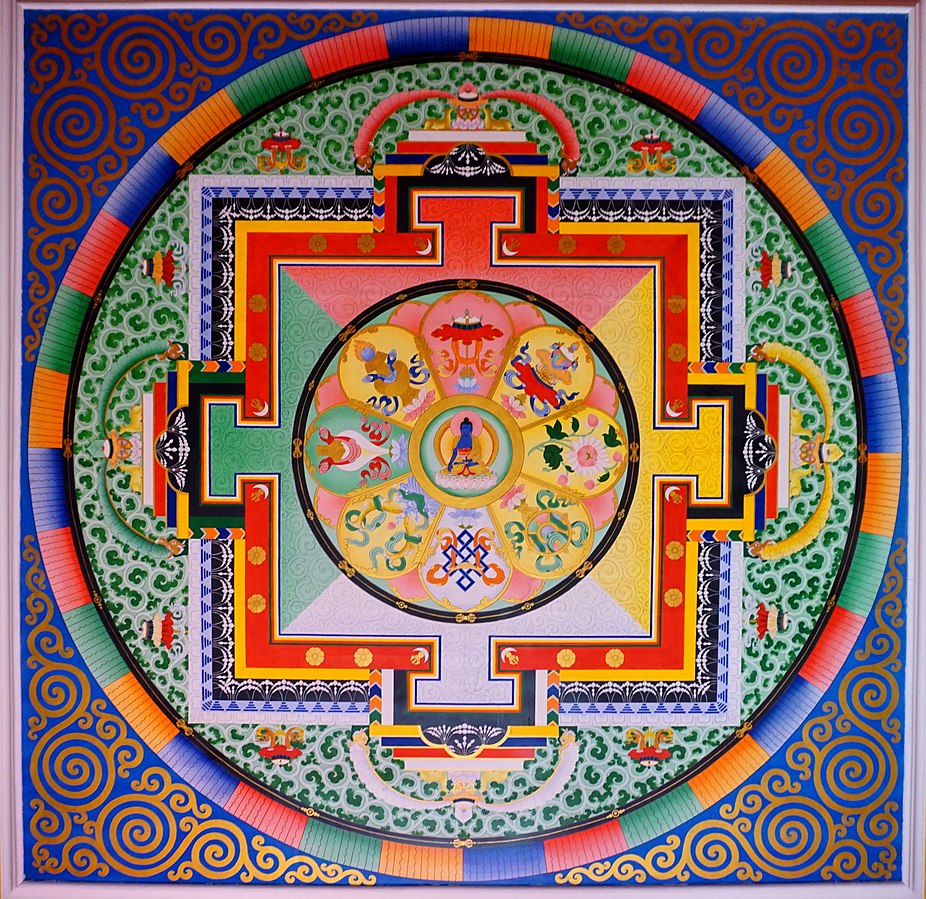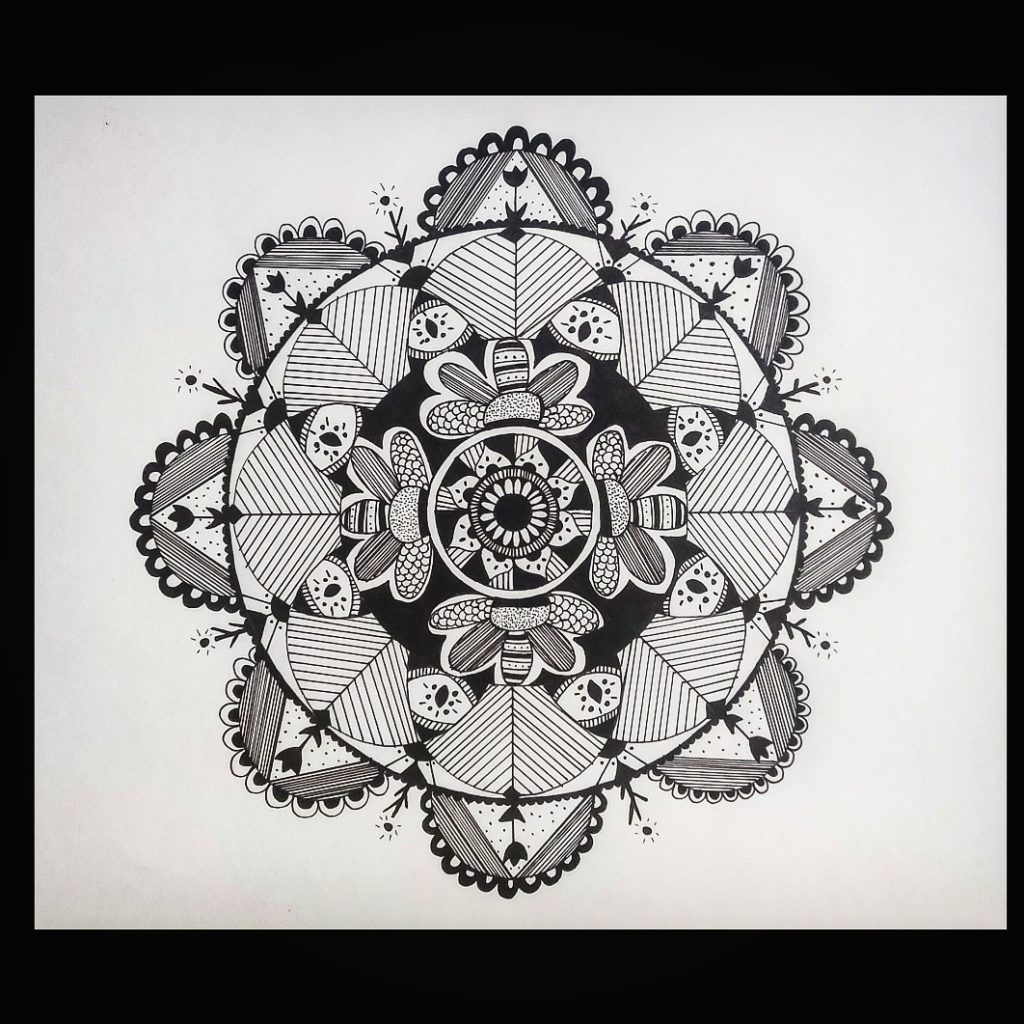
The Sanskrit word Mandala literally means “circle” or “discoid.” A further dissection reveals the roots of the term: manda meaning “essence” and la meaning “container.” While Mandalas are more often than not simply overlooked as mere organized clusters of patterns used for the sole purpose of adornment, their significance goes way beyond. At the most basic level, mandalas include geometric shapes within a circular boundary, all centred around a single point. Additionally, the repeated usage of concentric circles is viewed as a representation of elements taken from nature, which are ever changing, yet permanent. The qualities of patience and precision are inevitable in their creation.
Genesis: The genesis of Mandala art can be traced back to the first century B.C. in Asia. It is believed that after Siddhartha Gautama attained enlightenment, his followers went far and wide, carrying these Mandalas with them in order to convince other sects and the general population about the validity of their philosophy. By the fourth century, this art form had begun to be absorbed in Tibet, China and Japan. The first piece of evidence in India, on the other hand, comes from the Tantric and Vedic texts dated around 10th century B.C., when rituals and sacrifices were considered as effective ways of communicating with the divine in the presence of Brahmins as facilitators of the process. These ceremonies were performed on altars that represented the cosmic world and were seen as a sacred space encompassed within a boundary, quite similar to the core ideas associated with Mandalas. Some scholars have predicted an even longer history, dating back to the oral traditions that were never recorded and the unavailability of records lost to the ravages of time.

The Hindu Connection: According to Hinduism, the primary objective of the Mandala, regardless of the time or place, is spiritual liberation from the material world. It allows the creator to fuse oneself with the deity and attain freedom from all forms of earthly desires that arise from negative emotions of greed, anger and irrationality. This also emphasizes the distinctiveness between Atman and Brahman by enabling the individual to realize the true self. What is even more intriguing here is that the construction of Mandalas is not necessary for such an experience. Deep contemplation and visualization of the form is considered to be enough for the same. Also known as cosmograms, Mandalas exhibit the ability to delineate the entire universe within a limited, defined space. As described by Buhnemann in her book titled Mandalas and Yantras in the Hindu Traditions, there are four basic types of Mandalas. The first one called Seat-Mandalas are two dimensional in nature and focus on the point as a place for the deity to rest. Image-Mandalas, the second type, are constructed using coloured sands. The third type, called distributive diagrams, involve the division of space into square grids and are used for healing purposes. The fourth type of Mandala is usually associated with the sun, the moon and the chakra.
The Buddha Connection: As per Buddhist tradition, on the other hand, the construction of Mandalas is seen as a journey from the outer designs towards the centre. The fusion of the creator of the Mandala with the architect of the universe, denoted by the mid-point of the circle forms the essence of this formation. In this sense, therefore, the Mandala creation journey is more like a pilgrimage, a visit to the deity’s abode. Buddhism also confers great importance to the time of construction, location of the Mandala and the materials used. The deconstruction of such Mandalas is also significant in the sense that they highlight the transient but repeated life cycles and the virtue of non-attachment.
Structurally, the Buddhist Mandala comprises of four concentric circles. The outermost circle, called ring of flames, represents knowledge. A protective barrier, it ensures the removal of the impurities of the individual before entering the sacred space. The second ring of eight cemeteries represents the world of senses. All the ‘eight superficial modes of consciousness that bind man to the rebirth cycles’ are eliminated so as to ensure determined concentration and composure on the individual’s part. The third ring of diamonds represents the immortal soul. The final layer called the ring of lotus symbolizes enlightenment and liberation from all sufferings. The centre or core of the Mandala houses the Buddha. Other commonly used symbols in Buddhist Mandala art are sun, bells and triangles. While sun represents energy and vitality, bells represent openness to experience and knowledge. Similarly, upward facing triangles symbolize action and downward-facing ones represent creativity.
The Western Link: Carl Jung, an influential Swiss Psychiatrist considered Mandalas to be “magic circles.” By asking his patients to draw and interpret these circular designs, he became one of the first few people to introduce this art form to the Western world. His first ever Mandala was made in the year 1916. According to him, Mandalas are manifestations of one’s own self or overall personality. Back then, the process of drawing Mandalas acted as a safe space for the patients to explore and express all aspects of their self with no inhibitions. Thus, for Jung, and a number of scholars who retraced his path, drawing, imagining and painting Mandalas is a way to achieve spiritual growth. Today, these are extensively used as therapeutic tools to achieve relaxation and promote subjective well-being in general. Various studies done in this regard have highlighted such positive outcomes of Mandalas. They not only allow expression of thoughts symbolically, but also aid in the process of transforming emotions.

The Other Impacts: Prototypical patterns of Mandalas and Mantras have influenced contemporary Indian art, dance and architecture. The Mumbai-based architect, Charles Correa, has taken inspiration from Mandala designs for his building layouts like Vidhan Bhavan in Bhopal, Jawahar Kala Kendra in Jaipur and Delhi’s Suraj Kund. Built on the core principles of this art, Mandala dance is gaining popularity as well. It essentially focuses on integrating dance movements, gestures, attention and breathing patterns in order to align energies at all levels. Additionally, it promotes teamwork, harmony and uniformity amongst the group members irrespective of the cultural or regional diversity.
As we have seen, Mandala art is being followed since time immemorial and has provided succour to the millions of people practicing it. Not only has it assisted in the process of venting out inner emotions, but has also led to the development of a harmonious relationship with nature. As a modern art form, Mandala is helping its creators to establish the quintessential primordial connection with their true selves, the Brahman, and making them all feel a part of His creation.
Supriya is currently pursuing a Bachelors degree in Psychology from Lady Shri Ram College for Women. A self confessed bibliophile, books are her constant source of solace. She finds it liberating to express her ideas through various forms of art.


